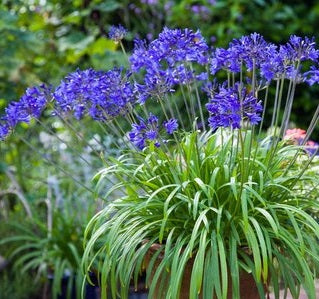Seasonal Agapanthus Care: Getting Ready For Winter Months and Summer season
Seasonal Agapanthus Care: Getting Ready For Winter Months and Summer season
Blog Article
Understanding the Art of Agapanthus Treatment: Crucial Actions for Healthy Development and Dynamic Blossoms
In the realm of cultivation, the farming of agapanthus stands as a fulfilling undertaking for those who seek to support these classy blooming plants. With their striking blooms and stylish vegetation, agapanthus has actually recorded the attention of garden enthusiasts worldwide. However, accomplishing optimal development and vivid blooms calls for a nuanced strategy that includes different important steps. From picking the right variety to grasping pruning methods, the journey in the direction of growing growing agapanthus plants is complex and holds the key to unlocking the full potential of these agricultural treasures.

Selecting the Right Agapanthus Variety

When picking the right Agapanthus variety for your yard, take into consideration elements such as climate viability, flower shade, and growth practice. Agapanthus, typically known as Lily of the Nile or African lily, is available in a variety of shades varying from shades of purple and blue to white. Pick a blossom shade that matches your existing yard scheme to create an unified landscape. In addition, think about the environment in your region to make sure the Agapanthus selection you pick can thrive in your particular conditions. Some selections are much more tolerant of cool temperatures, while others like warmer climates. Recognizing the growth behavior of various Agapanthus varieties is essential for correct positioning within your garden. Some selections have a clumping development routine, suitable for boundaries or containers, while others have a more spreading nature, appropriate for ground cover or mass plantings. By thoroughly evaluating these elements, you can choose the excellent Agapanthus range to enhance the charm of your garden.
Suitable Growing Problems
Thinking about the optimal ecological needs is essential for effective Agapanthus farming. Agapanthus plants are sensitive to cool temperatures and must be safeguarded from frost throughout winter season months.
To make sure healthy and balanced development and dynamic blooms, plant Agapanthus light bulbs at a depth of regarding 2-4 inches and room them 8-12 inches apart. Mulching around the base of the plants helps preserve dampness and subdues weed growth.
Watering and Fertilizing Tips
Maintaining proper dampness levels and supplying vital nutrients are vital aspects in the care program for Agapanthus plants. When it comes to watering Agapanthus, it is important to strike a balance. These plants prefer regularly wet soil yet are susceptible to root rot if overwatered.
Fertilizing Agapanthus is necessary for advertising healthy development and respected flowers. Use a well balanced fertilizer, such as a 10-10-10 formula, in the very early springtime as brand-new growth arises. Repeat this application every 6-8 weeks throughout the expanding season. Avoid extreme fertilizing, view it as it can result in rich foliage at the expenditure of flowers. Constantly adhere to the supplier's instructions for correct dilution and application methods. By complying with these watering and feeding suggestions, you can ensure your Agapanthus plants flourish and produce vibrant, lasting blooms.
Pruning Techniques for Agapanthus
Trimming Agapanthus plants at the proper times and with proper techniques is important for maintaining their wellness and promoting optimum growth and flowering. The perfect time to trim Agapanthus remains in late winter or very early spring prior to brand-new development arises. Beginning by eliminating any kind of yellowing or dead leaves near the base of the plant. Cut them as short as feasible without damaging the arising shoots.
For flowered stems, wait till the blossoms have actually withered and after that trim them back to the check my source base. This not just tidies up the plant's look however additionally encourages the growth of brand-new blossom buds. Deadheading spent flowers can additionally reroute the plant's power right into generating even more flowers rather than setting seeds. However, if you intend to gather seeds for proliferation, leave some blossoms to completely dry and mature on the plant.
Remember to utilize clean, sharp devices to make exact cuts and decrease the threat of introducing illness. Agapanthus. Routine pruning will certainly help keep your Agapanthus looking neat and healthy while making sure a bountiful display of beautiful blooms
Handling Common Insects and Illness
After making sure correct pruning strategies for Agapanthus, it is essential to address typical pests and diseases that can pop over to this site influence the health and wellness and vitality of these plants. One typical parasite that influences Agapanthus is the Agapanthus gall midge.
Furthermore, Agapanthus plants can experience from root rot if they are planted in poorly draining pipes dirt. By being cautious and taking punctual action versus pests and diseases, you can aid your Agapanthus plants flourish and generate vibrant flowers. Agapanthus.
:strip_icc()/purple-agapanthus-4637b426-ba6babc24ea34dce9361ec746f6ebc63.jpg)
Conclusion
In verdict, understanding the art of agapanthus care involves selecting the ideal variety, giving excellent growing conditions, appropriate watering and fertilizing, appropriate trimming techniques, and attending to common parasites and diseases. By adhering to these important actions, you can make certain healthy and balanced development and lively blooms for your agapanthus plants. Keep in mind to routinely keep an eye on and preserve your plants to promote their general well-being and long life.
To make certain healthy growth and lively blossoms, plant Agapanthus bulbs at a depth of concerning 2-4 inches and area them 8-12 inches apart. By adhering to these watering and fertilizing suggestions, you can ensure your Agapanthus plants prosper and produce vivid, lasting blooms.
One usual insect that influences Agapanthus is the Agapanthus gall midget. In addition, Agapanthus plants can experience from origin rot if they are grown in improperly draining dirt. By adhering to these crucial steps, you can ensure healthy development and vibrant flowers for your agapanthus plants.
Report this page